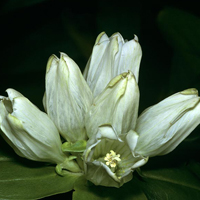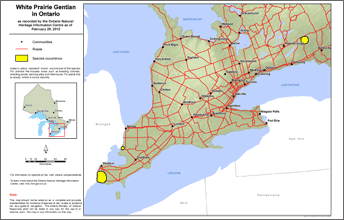White prairie gentian
Scientific name: Gentiana alba

Cover photo credit: Allen Woodliffe
Status
Endangered
“Endangered” means the species lives in the wild in Ontario but is facing imminent extinction or extirpation.
Date added to the Species at Risk in Ontario List
The White prairie gentian was already assessed as endangered when the Endangered Species Act took effect in 2008.
What it looks like
The White prairie gentian is a flowering plant that can reach 90 centimetres tall. It has up to a dozen stems and large, oval-shaped, yellowish-green leaves.
Creamy white flowers appear in dense clusters at the top of the stem and in the upper leaf axils (where the leaves join the stem). In the fall, the seedpod splits in two to release hundreds of tiny seeds which are dispersed by the wind.
Where it lives
In Ontario, the White prairie gentian grows in open and sunny oak-hickory savannah, a rare type of habitat with grassland prairie growing between scattered mature trees.
The habitat requires a regular fire regime (the pattern that fire follows in a particular ecosystem) to prevent encroachment by trees and shrubs.
Where it’s been found in Ontario
In Canada, the White prairie gentian is currently found only in southwestern Ontario on lands of the Walpole Island First Nation.
In 2000, fewer than 50 of these plants were found on Walpole Island. White prairie gentian was originally discovered at the turn of the 20th century in Northumberland County, east of Toronto and in Essex County, but these populations no longer exist.
View a larger version of this map (PDF)
What threatens it
The main threat to White prairie gentian is habitat alteration due to human activities, such as ATV use and development.
Natural succession, which is the gradual takeover of an area by trees and shrubs, creates shady conditions and is another factor contributing to habitat loss for this sun-loving plant.
The suppression of wild fires adds to a loss of suitable habitat, as fire is essential to maintaining a healthy prairie and savannah ecosystem by limiting natural succession.
Action we are taking
Endangered Species and their general habitat are automatically protected.
Recovery strategy
A recovery strategy advises the ministry on ways to ensure healthy numbers of the species return to Ontario.
Read the Executive Summary and Full Document January 28, 2016)
Government response statement
A government response statement outlines the actions the government intends to take or support to help recover the species.
Read the government response statement (October 28, 2016)
Review of progress
A review of progress made toward protecting and recovering a species is required no later than the time specified in the species’ government response statement, or not later than five years after the government response statement is published if no time is specified.
Read the report on progress towards the protection and recovery of 18 species at risk, including White Prairie Gentian (2021).
Habitat protection
General Habitat Protection - June 30, 2013
What you can do
Report a sighting
Report a sighting of an endangered animal or plant to the Natural Heritage Information Centre. Photographs with specific locations or mapping coordinates are always helpful.
Volunteer
Volunteer with your local nature club or provincial park to participate in surveys or stewardship work focused on species at risk.
Be a good steward
- private land owners have a very important role to play in species recovery; if you find White prairie gentian on your land, you may be eligible for stewardship programs that support the protection and recovery of species at risk and their habitats
- pollinators, such as bees, are in steep decline across the globe and they play a key role in the survival of many of Ontario’s rare plants; for information on how you can help scientists monitor pollinator populations in Ontario visit:
www.seeds.ca/proj/poll - White prairie gentian and many other species at risk depend on healthy grassland prairies, a very rare habitat in Ontario; learn more about these habitats, the species that depend on them, and what you can do to help at:
www.tallgrassontario.org
Report illegal activity
Report any illegal activity related to plants and wildlife to
Quick facts
- bumblebees are one of the few insects that are strong enough to open the White prairie gentian’s flowers and pollinate them
- fire plays a very important role in maintaining open prairie habitat where the White prairie gentian lives; fire stimulates the growth of these hardy prairie flowers and naturally removes trees and shrubs that would otherwise overtake this unique habitat
- tallgrass prairie provides habitat for White prairie gentian and more than 500 other plants, many birds, mammals, reptiles, butterflies and other insects
- the root of the White prairie gentian has been used by Aboriginal people as a medicinal tea
